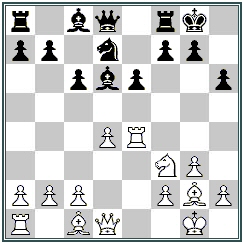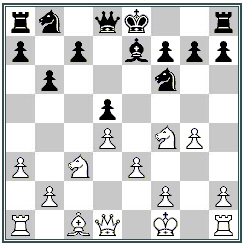|
'Opening preparation for the Club Player'
Upwards of 30 people attended
Peter Well’s lecture on (almost) the above
topic, organised by Witney CC, and a pleasant
and thought-provoking evening resulted –
punctuated by lively discussion, tea at the
interval and some post-match pub analysis in the
Bell Inn.
In his opening remarks, Peter
dealt with a range of openings-related issues
that have been delayed from appearing at a chess
bookstall near you by the arrival of his first
child in November. It would be facile to pretend
my notes cover the breadth of commentary – but I
recall a starting point with the Nigel Short
observation (I think) that people (i.e. the
audience) generally do tons of work on the
opening … badly – and how openings books divided
between those selling variations, and others
providing ideas – with the (I think) unspoken
conclusion that ‘never the twain shall meet’ for
many people.
And, perhaps for that reason,
players tended to get caught either in a fug of
variations which never appeared in their games
(and were generally forgotten until they
appeared in some World Championship match twenty
years later), or they floated into the match
room with an aura of positively beautiful chess
ideas, only to see them get shot down at 7.40pm
of a Monday, by which time their opponent has
unhelpfully unfurled the Colle system in
reductio ad absurdum. Beautiful.
In passing he mentioned that
the lecture title wasn’t quite that which he had
signed up for – the preferred title being more
economical and losing the last four words of the
advertised title. A good move, I felt. It is
better to let club players in to the GM’s
approach to the opening, than for a more
generalised GM “doctor-is-in” post-mortem into
the many disasters that befall the club player
in their travails – club players would have
fewer disasters if they did some openings prep
properly. [ … and besides, doesn’t Gary Lane
already provide such an invaluable service in
Kingpin
(which also suggests some other forms of GM
preparation for which the club player probably
needs no introduction…)]
The first part of the lecture
was structured around McShane – Palliser from
the February 4NCL played the day before, which
Peter had witnessed from the next board. A
non-standard closed Sicilian after White
deviates from known book as early as 6. a3, and
– without any obviously bad moves on Black’s
part – White gradually finds and executes a plan
which sees both his knights land on f4 and g5,
whence to impose a pawn presence in the centre,
gaining control of the c-file choices, and
culminating around move 39 with the invasion of
the rook to c7 – almost the first aggressive
sortie into his opponent’s half of the board.
Peter’s treatment here was
more autopsy than post-mortem – looking at how a
very good player was rendered powerless by what
seems on a casual replay to be a series of
extremely sensible, dare-I-say simple, moves.
That White (much more than Black) has a wider
scope to indulge in such ‘fantasy’ play is a
factor – and the plain deceit of some moves was
interesting to have noted. (a3, Bd2, and Rb1 all
hint strongly at queenside play initiated by b4
- and while this does ultimately result – these
preparatory moves seem to divert Richard from
the Knights’ tours on the other side of the
board.)
A final point that stuck with
me was the approval Peter had for this game,
which while having some element of midnight oil
in terms of preparation, contrasted with what
seems a disappointment that the Nakamura –
Howell draw in London 2010 was for the most part
all openings prep by Nakamura – he knew the game
was drawn with best play and left Howell to find
the ‘only’ moves to the draw). It’s a worrying
trend … but not one that will immediately impact
on the club player.
In the second half, and
enlivened by tea and biscuits and the
opportunity for discussion not normally
available on a Monday club night
(pictures),
the debate was thrown open. To queries as wide
as computer chess, prepping, internet chess, and
favoured chess players – a list which went
to-and-fro and included McShane, Short, Miles,
Rozenthalis, and Hebden….
On the proper preparation for
openings, some valuable hints emerged:
-
main lines are main lines
for a reason
-
maybe you can start work
in the middle game (or: examine middle games
that arise from your opening) and Peter’s
Grunfeld game against some un-named German
was an excellent illustration
-
be aware of pawn
structures and how structures in openings
(The Zaitsev Ruy, the Sveshnikov) overlap
and lead to similar thematic continuations
and though they might not be
followed up immediately, or in some cases, ever
– it is helpful to know where the road to
improvement lies, even if (as it sometimes the
case) some of the audience are looking for a
route to more enjoyment…
I particularly enjoyed the
“cost-effectiveness openings study” debate –
initiated by Simon King, and which sees White
cut out 400 columns of MCO by studying instead
the 21 columns that deal with the Closed
Sicilian. Peter seemed to think this was a good
approach – and many club players adopt this –
though an unexpressed drawback would seem to be
the limited range of opportunities for
excitement. If you want “exciting chess”, then –
depending on how you define your terms – you
might need to broaden your repertoire. (That
said, if you think winning alone makes for
exciting chess, and are getting your fair share
of victories, then maybe you don’t need to buy
more books.)
An excellent evening
entertainment was continued into Bell Inn, where
the GM wound down actively as the Pubformator™
gang wound itself up, and revealed some of the
secrets of “How to Maintain a Club Player
Repertoire” (and remain, I suppose, a Club
Player), which included some annotations such
as;
22. … Nb6
Now my plan to play 23. Bc4
was in ruins because when he played this move he
looked away from the c-file and towards the
king-side.” and discussed the following diagram:

White to move
where the open question was
“when Black plays … Nf6, do you (a) retreat the
rook (the sober strategic option) or (b) punt it
to h4 (the hacker’s choice)”, but of course the
real question was “how guilty should I feel if
it turns out I’m a happy hacker?”
We leave the reader to decide
for themselves… in the meantime, a vote of
thanks to the Witney Club for its hosting of the
event, the provision of demonstration board and
Grandmaster, and in particular to the anonymous
supplier of the extra strong, “Deep” Blu Tac
which held the games together during time
trouble.
- Sean Terry 06
March 2011
Thinking more about this in
the meantime, and how the club player’s
perspectives differ from those of the GM, I
found myself looking at one of the books
mentioned by Peter (Watson’s Chess Strategy in
Action) and came across this diagram in chapter
2:

Botvinnik –
Smyslov (Game 2, 1954, WCh)
where White has just played
10. g4, a move which – when I first remember
seeing it properly, about 10 years ago – pleased
me tremendously. “bloody hell, imagine the old
geezer playing that, and in a World Championship
match” summed it up. Contrast that with the
book’s verdict:
10. g4! Peter Wells
commented upon this famous move, which seems to
expose the wing upon which White’s king resides:
“It’s all here: space; driving/restricting
pieces, even the pawn-storm – even prophylaxis.
The implied threat to d5 will discourage Black
from ever
considering counterplay in the centre (with …
c5) and hence the ‘fixed centre’ which
encourages White’s win ambitions looks here to
stay. It also has, crucially, timing. If Black
had a tempo either to castle or to play … c6, he
would be able to organize his knights optimally.
As it is, they are likely to impinge on each
other’s space since they both need to land on
d7. Thus are space advantages driven home.”
Secrets of
Modern Strategy, p. 81
It’s easy to see a shared joy
– between patzer and Pulitzer, as it were – at
the move itself, and it’s not one which can be
explained by any traditional, coin-throwing,
aesthetics of the move – but a greater
understanding appears in the GM’s comments,
along with some concrete advice about how to
apply the ideas implicit in Botvinnik’s move to
one’s own chess player career.
In the meantime, we will await Peter’s book
...
PGN of games from Peter's lecture.
Click to play through the games



|